Unit 4: function (grammatical) words

This Unit is concerned with four classes of words which, when they
stand alone, have no obvious meaning. If, for example, you
check in a dictionary for the meaning of a word like by,
you will find that it has multiple meanings and that the meanings
can only be made clear by giving examples in context so you can
distinguish between, for example:
She stood by the door
It was written by Dickens
North by north west
The room is two metres by four metres
and so on (and on).
So, a question such as:
What does by mean?
is essentially meaningless because the person asked is likely to
respond with something like:
As in?
Function words are often called grammatical words because their job
is to make the grammar of the language work rather than supplying
meanings by themselves.
They only mean anything definite when they occur with content
lexemes so, for example:
her, was, in, the
mean nothing at all to most people, but:
Her car was left in the car park
carries real meaning when we combine the function words with
meaning-carrying lexemes.
The other distinctive characteristic of function words is that they
belong to closed classes to which additions are very rarely made in
any language.
We can happily make new nouns, verbs, adjectives and adverbs in
English to describe new ideas or new activities but we very rarely
invent new function words.
It is, therefore, possible, in theory at least, to assemble a list
of all the prepositions, all the determiners, all the pronouns and
all the prepositions of English although in some cases, the list
would be very long.
There are some of these linked from the
list of
lists on this site (new tab).
There are 4 sections to this unit and here's the menu.
Clicking on the yellow arrow at the end of each section will return you
to this menu.
| Section | Looking at: |
| A | Pronouns Words that stand for other words. |
| B | Prepositions Words which link verbs and nouns. |
| C | Conjunctions Words which join ideas. |
| D | Determiners Words which control how we think about nouns. |
Another set of words often described as function words concern modal and primary auxiliary verbs but, because they are somewhat different, the former are dealt with in Unit 7 and the latter in Unit 8.
Section A: pronouns
 |
A task |
In this list there are some true pronouns.
Can you identify them? Click on
![]() to show the answer.
to show the answer.
| 1 | She was carrying her books |
| 2 | Mary and John don't think so |
| 3 | Pass me that one |
| 4 | The children argued with each other |
| 5 | It is difficult to do |
| 6 | Is this book yours? |
| 7 | Pass him those papers |
| 8 | The sun burnt my skin |
| 1 | She was carrying her books | This contains one pronoun, she, only. The word her is a determiner, referring to books. |
| 2 | Mary and John don't think so | This sentence has no pronouns but the word so functions a bit like one because it stands for the idea that Mary and John do not think is correct. Here, the word is a pro-form, not a pronoun. |
| 3 | Pass me that one | This sentence contains two pronouns: me and one. The first is a pronoun standing for something like this person and the second stands for the noun that the person is referring to. The word that is not a pronoun, it is a determiner referring to the pronoun one. |
| 4 | The children argued with each other | This contains a rather unusual pronoun which is a short phrase, each other. It is called a reciprocal pronoun and there is one more of those in English: one another, which means the same but is more formal. |
| 5 | It is difficult to do | This is not easy. It is hard
to say what the word it represents in this
sentence. This is usually called an anticipatory or
dummy
it and stands for the subject of what is difficult.
It is a pronoun but a special use. When we say something like: It is raining then we can see that the first word is a pronoun but it stands for nothing recognisable as a noun. |
| 6 | Is this book yours? | This contains the pronoun yours which is called a possessive pronoun and it stands for the phrase your book. The word this in the sentence is not a pronoun, it is a determiner telling us about the book. |
| 7 | Pass him those papers | This contains one pronoun, him, which refers to the indirect object of the verb pass. The word those is not a pronoun, it is another determiner. |
| 8 | The sun burnt my skin | This does not contain a pronoun. The subject of burnt is the sun and the object is my skin. The word my is a determiner. |
In the list above, we have examples of subject pronouns (she,
it), object pronouns (me, him), a reciprocal pronoun (each
other) and a possessive
pronoun (yours). We also have the pronoun one
which can be both a subject and an object pronoun.
As you see, we also have examples of words that look like pronouns
but are determiners acting not to replace the noun but to refer to it.
Section D of this unit tackles that area.
 |
Terminology |
If you read a little about this area, you will come across two key terms which you need to understand.
- When we use a pronoun to stand for a noun (which is what they do), we refer to the pronoun as the reference
- and the thing it stands for as the referent
So, for example
in:
John bought
the car because
he needed
it
we have two references and two referents:
he is the reference for the referent
John
and
it is the reference for the referent
the car.
Notice that the referent can be a phrase rather than a single lexeme
or it can be a clause as in, respectively:
He said to put it
under the table so I left
it there
in which the word
there refers to under the table.
He told me when she was arriving and I passed
it on
in which the word
it refers to when she was arriving.
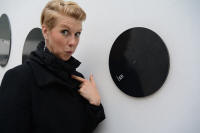 |
Personal pronouns |
As the name suggests, personal pronouns refer to people (although one of them can also refer to things). In the following examples, you can see how they work in English. The pronouns are highlighted in red.
| This sentence changes to | → | this sentence with pronouns |
| This writer wrote the word | I wrote it | |
| These hosts invited the guests | We invited them | |
| The person I am talking to wrote the word | You wrote it | |
| This man married that woman | He married her | |
| This girl hit that boy | She hit him | |
| The stone broke the window | It broke it | |
| The people bought the cans | They bought them | |
| That baby woke these people up | It woke us up |
Here is the usual list of personal pronouns in English, with some notes:
| subject | object | |||
| 1st person | singular | I | me | |
| plural | we | us | ||
| 2nd person | singular | you | ||
| plural | ||||
| 3rd person | singular | masculine | he | him |
| feminine | she | her | ||
| impersonal | it | |||
| neuter | they | them | ||
| plural | they | them | ||
Notes:
- There are three persons in English:
- First person refers to the speaker or speakers: I, we, me, us
- Second person refers to the person who is addressed: you
- Third person refers to neither the speaker nor the addressee but to someone else: he, she, it, they, him, her, them
- English distinguishes between singular forms (I, me, he,
she, it) and plural forms (we, they) for most
pronouns but does not distinguish in the second person when the
pronoun is always you.
Most other languages (especially European ones) distinguish between you plural and you singular and also between you familiar and you unfamiliar (the tu-vous distinction in French for example). - Apart from you and it, English makes a
difference between pronouns as the subjects (I, we, he, she,
they) and pronouns as the object (me, us, him, her,
them).
Subjects and objects are discussed in Unit 5 of this course. - The pronouns they and them are
increasingly used for singular people when we do not want to
identify their sex so we get, e.g.:
When a student books they must pay the fee.
Some people don't like this use but it is quite legitimate these days.
Take a little test to see if you can match the pronoun to its description.
The English system of personal pronouns is quite simple. We
have, in English, no way to distinguish between I masculine
and I feminine or between they masculine and
they feminine, for example.
We also have no way to distinguish different forms of you
at all.
Many other languages are more complicated and have pronouns for, for
example, we including you and we excluding you and lots of other forms.
Some languages have masculine and feminine forms of you and
some even have two gendered forms for I and we.
 |
Possessive or genitive pronouns |
| It's mine |
Again, the system in English is quite simple but, again, there
are some gaps in it.
Possessive pronouns stand for expressions such as my house, her
car, their friends and so on.
Here are some examples:
| This sentence changes to | → | this sentence with pronouns |
| That is my book | That is mine | |
| Can I borrow your pen? | Can I borrow yours? | |
| She has a blue car | The blue car is hers | |
| That is his house | That is his | |
| I showed him our furniture | I showed him ours | |
| We borrowed their car | We borrowed theirs |
Notes:
- There is no genitive or possessive pronoun for it.
We can say, e.g.:
That is its case
but we cannot, in English, simply say:
*That is its - The form of the genitive pronoun for he is exactly the same as the form of the possessive determiner: his
- In the examples on the left above, we have used the possessive determiners (my, your, his etc.). These are not, whatever you may read on the web, pronouns. Determiners are the subject of Section D of this unit. Be patient.
 |
Other pronouns |
| Something broke it |
There are a number of pronouns which can stand for people and
things which are not personal because we cannot identify the
referent, only the sort of thing to which the reference points.
Here are examples of the most important ones. It is not a
complete list but there are links to other guides with more details
below.
- demonstratives

- We shall meet demonstratives again when we come to
determiners.
The words in questions are this, that, these and those.
Here are examples of all of them acting as pronouns:
He wanted me to lend him the Greek recipe book but I couldn't find that
If you are having difficulty opening the can, try this
These are the books I wanted to show you
These ice creams are great and I want to try those, too. - both, none, either, neither

-
Both seem happy
enough.
She asked all the neighbours but none knew
Give me one of those pens; either will do
I tried both doors but neither was unlocked -
some, any, every, no + -one, -body, -thing

-
Somebody left the door open
Everybody complained
No-one understood her
Anyone who wants to come is welcome
Have you got everything?
Have I forgotten something?
There are those who will tell you that we use the some series in positive sentences and reserve the any series for negative and question forms but, as the last example shows, that's just not true (see note 3. below). - the same

- This is a common pro-form for noun phrases:
I'm having a beer. Do you want the same? - it, that, there, here

- These three words sometimes function as pronouns
but can stand for phrases and whole clauses.
Many analyses, including the one on this site, prefer to refer to these items as pro-forms rather than simply pronouns but for teaching purposes, the distinction is probably unnecessary.
For example:
She asked me to wash the car and check the oil and so on and I did it / that the next day
She said it would be OK in garage so I put it there
It seemed a good idea to keep the laptop in a safe place so I kept it here
Notes:
- None of these pronouns changes for person or when it acts as the object or subject of a verb so they are quite simple to use.
- When we use the some, any, no, every series, any
adjective follows the pronoun so we have:
Did you meet anyone nice?
and not
*Did you meet nice anyone
etc. - It is true that we use any forms in questions and
negatives so we get, e.g.:
Can anyone help?
I don't want anything like that
instead of:
Can someone help?
I don't want something like that
but the second two forms are not wrong.
We use the some series when we are fairly sure that someone can help and we can see something we don't like.
The some forms are frequently used when we dress up a question as an offer as in, e.g.:
Can I get you something to eat? - none, either and neither are grammatically singular and both is, of course, always plural.
 |
Reflexive pronouns |
| photographing themselves |
English uses reflexive pronouns but does not have an obsession
about them. The language does not, for example, insist that
some verbs are always reflexive as many languages do so we do not
usually say:
I washed myself
allowing
I washed
to be interpreted as reflexive when no object is identified.
The pronouns we are discussing are:
| First person | singular | myself |
| plural | ourselves | |
| Second person | singular | yourself |
| plural | yourselves | |
| Third person | masculine | himself |
| feminine | herself | |
| non-personal | itself | |
| *neuter | themselves | |
| plural | themselves |
Notes:
- These are referred to as co-referential (i.e., they refer to
the same thing) in some grammars.
We don't say, for example,
Sue wrote Sue a note
unless there are two Sues, but prefer
Sue wrote herself a note
When we use an object to refer to the same noun as the subject, in other words, English uses the reflexive pronoun. - English has few obligatorily reflexive verbs. We don't, for example,
meet ourselves (as we do in German), remember ourselves
(as we do in many languages) or (usually) wash ourselves.
However, we can make many transitive verbs reflexive if we want to:
I poured myself a drink
She drove herself home
etc.
The verb enjoy is, however, often used reflexively in, e.g.:
We enjoyed ourselves at the party. - This is the area where English actually does have a full set of pronouns, even to the extent of distinguishing between you plural and you singular (yourself vs. yourselves).
- You may hear or (perish the thought) be tempted to use theirselves instead of themselves. It's considered wrong in educated use as, incidentally, is the pseudo-pronoun themself.
 |
Learn moreIf you want to discover more now about pronouns, go to: |
 |
Take a test |
To make sure you have understood so far, try
a test of your
knowledge of pronouns.
Use the 'Back' button to return when you have done that.
Section B: Prepositions
 |
It's behind you |
Prepositions in English usually come before a noun phrase and tell us the
relationship between two things. For example, in
The man was
standing on the street
the preposition, on, tells us the relationship
between stand and the street.
They are difficult to learn for a number of reasons.
- They do not readily translate between languages so, for example,
we have the English
She took it off the table
being in German
She took it from the table
and so on.
It is also the case that a preposition in one language may be translated a number of ways in English depending on the context and vice versa. - Some languages do not use prepositions at all, preferring to
change verbs or to insert postpositions such as
She walked the road along.
(English sometimes does this, too, in things like
The whole day through
but it is unusual.) - Prepositions perform multiple tasks so we have
I met her at the station at 1 o'clock
where at is performing two different, if related, functions, referring to place the first time and to time the second time. - Prepositions need not be single words such as on or off. There are many which are two words such as apart from, out of or next to and some like as well as which are three words long.
- There is a certain randomness about the use of prepositions in many languages and English is no exception. We say, e.g., in the morning, in the evening and in the afternoon but at night.
The prepositional phrase
A prepositional phrase consists of the preposition and its complement
(usually a noun or pronoun).
In some analyses, you will see the complement referred to as the
prepositional object. That's OK, too.
Prepositions are structural or functional words and carry no meaning in
themselves. A
prepositional phrase is generally the target of teaching, therefore.
 |
Common prepositions |
A list of all the prepositions in English runs to over 200 words but
many are rare or obsolete words such as athwart, betwixt and
pursuant to. Except at quite advanced levels, these are
probably best left alone.
There are far fewer common prepositions which form the majority of
prepositional phrases. Think of 10 and then
click
![]() for a list.
for a list.
| about above across ago at before below |
beside by for from in into next to |
of off on onto out of over past |
since through till to towards under until |
Not only are these prepositions the commonest ones, they are among
the commonest words in English. It is hard to imagine a written or
spoken text in which some don't appear.
(Note: ago is in this list but many would categorise the word
as an adverb rather than here where it forms the only example of a
postposition.)
 |
Making sense of prepositions |
The two fundamental categories of prepositions are time and place.
Some of the prepositions above can act in
both ways (at 6 o'clock, at the bank), some only refer to place
(beside the road) and some only to time (since 1940).
Here's a list.
| Time only | Place only | Time and Place |
|
(six months) ago for (two hours, weeks) since (the war, 4 o'clock) till (midnight) until (7, dawn) |
above (the airport) across (the street) below (the plane) beside (the river) from (London) into (the box) next to (the house) off (the road, the top) onto (the table) out of (the box) through (the park) |
about (the house, twenty minutes) at (the corner, 6:15) before (4 o'clock, me) by (my side, 6 o'clock) in (an hour, the class) of (the house, December) on (Monday, the table) over (a week, the town) past (four o'clock, the door) to (the end of the day, the corner) towards (the station, dawn) under (a month, the table) |
(The preposition of appears in the third column but is
slightly unusual because it acts as a genitive linker usually.
You may believe that till and until can refer to
place as in, e.g.:
Walk on till the end of the road
but in reality, the preposition refers to time and the phrase is an
abbreviated form of:
Walk on until you get to the end of the road.)
 |
Prepositions of time |
| Preposition | Use | Example |
| on | days | on Monday, on my birthday |
| in | months time of day year period of time |
in January in the morning in 1998 in two years |
| at | night weekend / holidays point in time |
at night (time) at the weekend, at Christmas at 4 o'clock |
| since | from a point in time | since then, since 2009 |
| for | a period of time | for a week |
| ago | postpositional for period of time | two years ago |
| before | earlier than a point in time | before 9 |
| to / till / until | showing start and finish duration |
from now to eternity until the end of the day |
| past / to | time telling | ten past, quarter to |
| by | at the latest | by 10 o'clock at least |
Issues
- since, for and ago
- cause serious problems because their concepts vary across languages.
Errors such as
I have worked since 4 hours
are common.
The word ago is particularly unusual in English because it follows rather than precedes the noun phrase. It is, in fact, not a preposition at all, it's a postposition. - on, in and at
- cause problems for similar reasons. Teaching in the morning, for example, as a single item is a solution rather than asking learners to match prepositions to time expressions.
- by
- In many languages until
is synonymous so you will hear
Be here until 6 o'clock
(when by or before is meant).
 |
Prepositions of place |
| Preposition | Use | Example |
| on | attached for surfaces sides public transport media |
on the wall on the table on the right, on the front on the bus on TV |
| in | buildings private transport within |
in the house in a car in a book, in a box |
| at | exact place (relatively) events work places |
in the station, at platform 6 at the party at work, school |
| by, next to, beside | lateral proximity | by me next to her beside Mary |
| under | lower than (often covered) | under the road |
| over | higher than more than from one side to the other |
over my head over 21 over the table |
| above | higher than | above the city |
| across | from one side to the other on the other side |
(walk) across the road (be) across the road |
| through | between two limits | through the park, tunnel etc. |
| to | movement towards | give it to me to London |
| into | movement to inside | into the room |
| towards | movement in direction of | towards me |
| onto | movement resulting in on | onto the table |
| from | movement away | from the garden a present from her |
| out of | movement to the outside | get it out of the envelope get out of the car |
| off | downward or away movement | take it off the wall get off the bus |
Issues
- relative exactness
- in and at are often used in tandem to say that
one position is more exact than the other. For example
She is in London tomorrow and arrives at Paddington
When she's in the station, she'll ring and I'll pick her up at the entrance.
(Compare: I'll see her in the morning at 11.) - above, over, below, under
- sometimes cause problems because above and below
imply relative height but over and under
often imply position exactly. So we get,
The plane flew below 5000 feet directly over the town
I couldn't see the key because it was under the paper
In future, I'll hang it on the hook over the door. - movement
- is handled differently in many languages so expect error such as
*I saw it onto the table
or
*I looked into my pockets.
Additionally, onto and into only imply movement but on and in can imply position or movement.
Out of usually implies movement but is often used by learners for position so we get
*It's out of the box
rather than
It's outside the box.
(There are also times when out of does refer to position:
I left it out of the house.)
Here's a diagrammatic summary:

Source: adapted from Quirk and Greenbaum (1973:146)
Here are two examples of how that might look converted to mini-video presentations and, yes, of course, you may use them in your lessons (and yes, we know that middle of is not a preposition but it acts a bit like one).
| in | inside | on | under | above | outside | into | out of | off | between | aboard | across | ahead of | behind | beside | over | middle of | in front of | through |
 |
Other functions of prepositions |
Considerations of time and place do not exhaust the ways in which
prepositions are used in English.
There is a link below to the in-service guide to the other meanings
of prepositions but, briefly, the words also manage to:
- Show causes (why did it happen?):
Due to his opposition, the idea was abandoned
Because of the rain, the game was called off - Showing agents (who did it?):
The window was broken by the children
The café was filled with children having lunch - Show support or opposition:
She's with me on this
They are against the plan - Show topics:
She talked about her family
He wrote a book on Persia - Show ingredients:
The cake is made from eggs, milk, sugar and flour
They built the wall with stones from the garden - Show similarities and differences:
That's very unlike him
She looks like her mother - Show concession:
In spite of the rain, we took the dogs out
I'm leaving despite the time
 |
Learn moreIf you want to discover more now about prepositions, go to: |
 |
Take a test |
To make sure you have understood so far, try
a test of your knowledge of prepositions.
Use the 'Back' button to return when you have done that.
Section C: Conjunctions
 |
Joining ideas |
A working definition of a conjunction is:
a word used to connect clauses or words within clauses
Can you identify the conjunctions in these examples? Use the definition given and your knowledge of word class.
- It was raining but we went for a walk anyway.
- There was no bread and no butter.
- I came early so I could help you get ready.
- I don't know whether to laugh or cry.
- If you can let me know tomorrow, it would be a great help.
- I can give you a lift and I can take the dog, too.
Click
![]() when you have an answer.
when you have an answer.
- It was raining but we went
for a walk anyway.
This conjunction joins two clauses together. You can't reverse the order of the clauses and keep the same meaning.
*We went for a walk anyway but it was raining
is nearly nonsense. - There was no bread and no
butter.
Here the conjunction and joins two noun phrases, no bread + no butter. - I came early so I could
help you get ready.
This is similar to sentence 1. but you can reverse the clauses and get the same meaning:
So I could help you get ready, I came early - I don't know whether to
laugh or cry.
Here, we have a conjunction which comes in two parts. They operate together and must both be present to make any sense. - If you can let me know
tomorrow, it would be a great help.
This is a common conjunction but you can reverse the clauses and still retain the same basic meaning (albeit with a shift in emphasis). - I can give you a lift and I
can take the dog, too.
Here, the conjunction and is joining two clauses rather than two nouns, as in sentence 2., but the function is the same.
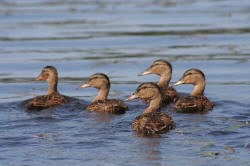 |
5 things conjunctions can do |
Can you classify the conjunctions in the examples above into the following five categories? Click on the table when you have an answer.

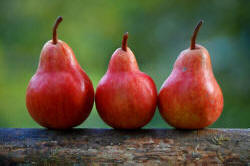 |
3 types of conjunctions |
Now we know what conjunctions do in sentences, we need to look at their grammar. In the examples
above, we have three sorts of conjunction.
Now what you need to know is:
- Coordinating conjunctions
join clauses or noun phrases of equal weight. This means that, although we lose the connection, both parts can stand alone and make sense.
So, for example:
I called but she was not at home
is a coordinated sentence and we can allow:
I called. She was not at home - Subordinating conjunctions
join main clauses to dependent clauses. This means that only the main clause can stand alone and the subordinate clause does not form a sentence which makes the same sense.
So, for example:
I arrived after they had finished lunch
is a subordinated sentence with the main clause:
I arrived
making sense alone but the subordinate clause:
After they had finished lunch
does not make a standalone sentence. - Correlating conjunctions
usually come in pairs and join two clauses or two noun phrases. They can be coordinating or subordinating depending on the conjunction.
So, for example:
He had hardly sat down when the telephone rang
She will either like it or hate it
are both examples of correlation but the first (hardly ... when) is subordinating and the second (either ... or) is coordinating.
A simple (and not always wholly reliable) test to check if we have a case of subordination or
coordination is to leave out the subject in the second clause. If
we can, as in:
I came home and (I) cooked dinner
then the clauses are coordinated, but if we can't as in:
*I went although was tired
then we have a case of subordination.
Can you identify these three types in the example sentences? Here they are again with the conjunction in bold:
- It was raining but we went for a walk anyway.
- There was no bread and no butter.
- I came early so I could help you get ready.
- I don't know whether to laugh or cry.
- If you can let me know tomorrow, it would be a great help.
- I can give you a lift and I can take the dog, too.
Again, click on the table when you have an answer.

Some notes:
- Coordinating conjunctions can only be placed between the clauses or noun phrases they connect.
- Subordinating conjunctions on the other hand are a bit more
mobile. We can say, e.g.,
She came because I asked her
and
Because I asked her, she came
with approximately the same meaning (although the emphasis varies). However, some subordinating conjunctions require a certain ordering because of the logic of what we are saying. We can have, therefore,
He was bored so he went to see his friends
and we can have
He went to see his friends so he was bored
but the meaning is radically different. - Some of the correlating conjunctions (the ones with a negative
implication) sometimes require us to insert a question form so we
say,
Barely had I taken my seat when the play began
This is called inversion, incidentally (and slightly misleadingly).
 |
Lists |
Here's a list of some of the most common conjunctions in English, ordered by type, with examples. Your task is to think of examples of your own so you are sure you understand.
| Coordinating conjunctions | Example | Subordinating conjunctions | Example | Correlative conjunctions | Example |
| but | Not me but Mary | because | He came because I asked | whether ... or | I'll say it whether you want me to or not |
| so | I came so I could help | if | If you go now, you catch the bus | not only ... but (also) | He is not only attractive but he's also rich |
| for | I can't read for the light is too dim | although | He drove although he was drunk | as ... as | He is as stupid as the day is long |
| and | I went and saw him | than | He works harder than she does | both ... and | Both my sister and her husband came |
| or | Either you stay or go | before | He arrived before I was ready | no sooner ... than | I was no sooner in the bath than the phone rang |
| yet | He works hard yet he gets nowhere | why | That's why you dislike him | either ... or | She will either explain it or show you how to do it |
| nor | I won't go nor will I let you | when | I'll come when I like | rather ... than | I would rather have a tooth out than watch that |
The only complete list in the table above is column 1. There are only 7 coordinating conjunctions in English by most reckonings. The other lists can be extended very considerably.
 |
Learn moreThis link takes you to the in-service guide to the area: |
 |
Take a test |
To make sure you have understood so far, try
a test of your
knowledge of conjunctions.
Use the 'Back' button to return when you have done that.
Section D: Determiners
 |
The gatekeepers |
Determiners are the language's gatekeepers – they control how
noun phrases are seen.
For example, the difference between:
Pass me a hammer
and
Pass me that hammer
is that in the first case the determiner (a) denotes a
hammer but it doesn't matter which hammer. We know what we
want but not which we want but in the second case the determiner (that)
points to a particular noun which is out of reach of the speaker.
Determiners are often quite simple words (although appearances can be
deceptive) and they always come before the element they modify.
For
example, we can understand a sentence such as:
Sugar should be kept in sealed containers
in which we have two nouns: sugar and containers.
Both the nouns are unmodified by any determiner but the sense is still
clear. The first noun, sugar, is not modified at all and
the second, containers is modified only by an adjective,
sealed.
We can, however, add determiners which will make what we say more
precise and get:
The
sugar should be kept in those
sealed containers
in which we have used two determiners (in
red) to control how we see the nouns.
We now know which sugar we are referring to and which sealed containers
are in
question.
In terms of meaning, determiners act to limit the noun they modify in some way, either by signalling what the speaker and hearer know about it (as articles do) or by saying where it is, whether it is singular or plural and how much or how many of an item we are considering.
 |
Six sorts of determiners |
In English, there are, essentially six sorts of determiners:
- Articles: a, an, the
and Ø
(the zero article)
For example:
She came on the bus
I need a new car
They lead an exciting life
I have Ø flu - Demonstratives: this, that, these, those
For example:
Take this money
Open that window
Let me show you these pictures
Do you want those cups? - Distributives: each, every, either, neither, both
For example:
Give every student a name tag
Each child gets the same report
Either car will be big enough
Neither restaurant is open
Both houses are too expensive - Interrogatives: what, which, whose
For example:
Which car is his?
What colours do you have?
Whose room is that? - Possessives: my, your, her, their etc.
For example:
That's my sister
Did they get their certificates?
The dog's hurt its leg - Quantifiers: some, many, enough, four, all, both etc.
For example:
I have some time to spare
Has he got enough money?
They have three holidays a year
Here's a summary with a few more examples:
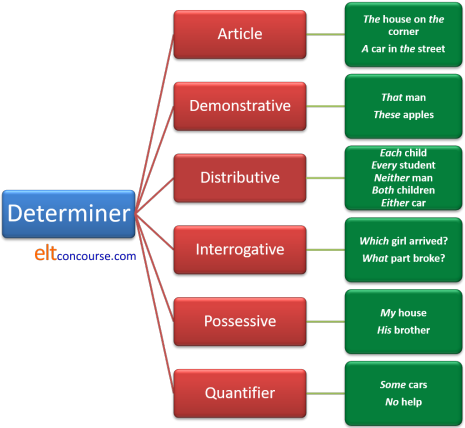
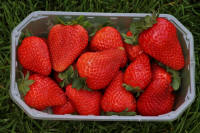 |
Count vs. mass nouns |
We saw in Unit 3 of this course that common nouns can be divided into
two classes: count nouns and mass nouns.
This distinction is critical when we come to looking at how determiners
operate.
It is not possible to understand or teach very much to do with
determiners unless this distinction is clear.
If you can't remember the distinction, review
that part of Unit 3 before
you continue (new tab).
Determiners work very differently depending on whether the noun they determine is a count noun or a mass noun. And, if it is a count noun, whether it is singular or plural.
 |
Mini-task: Can you say why the following six are wrong? Can you correct them? Click |
- Did they give you many help?
- Can you lend me a money?
- Have you got both information?
- There aren't much chairs here
- Pass those pencil
- Give me that books
Answers:
- Reason: the determiner many is only used with plural count
nouns.
Correction:
Did they give you much help? - Reason: the determiner a cannot be used with mass nouns.
Correction:
Can you lend me some money? - Reason: the determiner both can only refer to
two count
nouns.
Correction:
Have you got the information?
or
Have you got both pieces of information? - Reason: the determiner much is only used with mass nouns.
Correction:
There aren't many chairs here - Reason: the determiner those can only be used with plural
count nouns.
Correction:
Pass that pencil
or
Pass those pencils - Reason: the determiner that can only be used with singular
count nouns or mass nouns.
Correction:
Give me those books
or
Give me that book
or
Give me that paper
 |
Choosing the right determiners |
We are only dealing with a limited
range of the most common determiners. Much more detail is
available in the in-service guides to the area.
As we saw above, the choice of determiner depends on the nature of the
noun. There are three to consider:
- mass nouns
such as furniture, information, sugar - singular count
nouns
such as house, garden, knife - plural count nouns
such as books, children, mice
On the whole, determiners are mutually exclusive. That
means that we do not usually use two determiners to refer to the
same noun so, for example:
*The some men were here
*That the house is very nice
*My the money is here
*Some the pencils are broken
are all disallowed in English.
Other languages may allow these kinds of structures.
- Articles
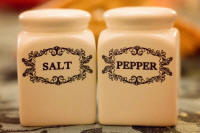
-
As we saw, there are three articles in English:
the: which is used when we specify or know what we refer to
a / an: when we refer to something identifiable but not to which specific instance of it
Ø The zero article which we use for mass nouns and plural count nouns when we are referring to them in general.
The main function of articles in English is to indicate what is known to the speaker and hearer or writer and reader about the noun in question. In other words, they act to specify a noun or leave it unspecified. There is a difference, therefore, between:
Ø Pepper used to be a very expensive spice
Ø Peppers are grown in India
A pepper plant has died
in which the reference is to all pepper and pepper plants or to an unspecified plant. We know what sort of thing is being referred to but not exactly which.
And, on the other hand:
The pepper is in the right-hand cupboard
The pepper plant has died
refer to particular specified instances of the noun. We know what sort of thing this is and, in addition, which it is.- The definite article can be used with mass nouns and
with plural count nouns:
Pass the salt
We missed the train
They stayed in the cottages by the sea - The indefinite article can only be used with singular count
nouns:
Lend me a pen
I planted an ash tree - The zero article (which looks like no article) occurs with mass and plural count
nouns:
Ø Cars are expensive items
Ø Dust gets everywhere
The zero article cannot be used with singular count common nouns so we do not allow:
*Ø House is on the corner
- The definite article can be used with mass nouns and
with plural count nouns:
- Demonstratives

-
Demonstratives perform a pointing function. They indicate
where something is in relation to the speaker / writer and they
also indicate what kind of noun is being mentioned (singular,
mass and plural).
The demonstratives these and this indicate that the item is near to the speaker and that and those indicate that it is further away. English cannot, as some languages can, indicate whether it is far from the hearer as well.- The demonstratives this and
that can only be used with mass
nouns or with singular count nouns:
I really like this furniture
That advice was unhelpful
She broke that glass
This house is too small - The demonstratives these and
those can only be used with plural
count nouns:
They lived in those apartments near the sea
Can you repair these pieces of jewellery?
- The demonstratives this and
that can only be used with mass
nouns or with singular count nouns:
- Distributives

- As the name implies, these determiners function to
distribute nouns and they can be inclusive or exclusive.
- each
is inclusive and treats the nouns as separate (and singular) so we have, e.g.:
Give each child a pen
Each of you must decide alone
When this determiner is combined with of it determines only a plural count noun (or pronoun). - every
treats the nouns inclusively but as a group rather than as individuals (hence its combination with -one, -thing, -body) so we have, e.g.:
Every part of the house was searched
Tell every customer the same thing
There are two issues with this word:- it must refer to more than two items or people so we
allow:
I broke every glass in the house
but not:
*He held a glass in every hand - it cannot occur with an of-expression so we
do not allow:
*Every of the children came
- it must refer to more than two items or people so we
allow:
- both
only refers to two entities and is inclusive so it occurs with a plural verb and pronoun forms as in, e.g.:
Both parents came to the party with their children - either
also refers to two entities only but is inclusive so it means that only one of the alternatives is not allowed. We can have therefore:
Either hotel will suit us
which means we can select a hotel but both the possibilities are included. - neither
is exclusive and signals that both alternatives are disallowed so, e.g.:
Neither hotel suits us
means that a third alternative must be found.
- each
- Possessives

- The main function of these determiners is to indicate
ownership but they can indicate other relationships including
origin and description as in, e.g.:
Her imprisonment was unjust
His reaction startled me
Your complaint has been rejected
My government is unpopular
His letter was a nice surprise- Possessive determiners can be used with any noun type,
mass, singular or plural:
My house is the one with the blue door
Her dogs are vicious
Their assistance is welcome
Your correspondence was ignored
His response was immediate
I think its batteries are dead
That is different from our information - In English, unlike many languages, possessive
determiners do not co-occur with most other determiners such
as articles demonstratives and interrogatives so we cannot
have, for example:
*Their the house is on the corner
*Which your book did she borrow?
*That their house is beautiful - They can co-occur with a
very limited range of quantifiers so we allow, for example:
Half my garden is untidy
All our effort has been wasted
but we do not allow
*Many my friends are here
*A lot their money was lost - We saw above in the section on pronouns that one possessive determiner, his, can also act as a pronoun but the others change their form when they are used in that way, with my changing to mine, her to hers, your to yours, our to ours and their to theirs. The possessive determiner its has no pronoun form at all.
- Possessive determiners can be used with any noun type,
mass, singular or plural:
- Interrogatives

- As the name suggests, these determiners occur in question
forms and signal the subject of the question.
The determiner whose refers to possession (or other characteristics (see above)), which implies a limited choice and what implies a more open-ended selection. So, for example:
What train did he take?
suggests that the questioner has no idea at all and there is an almost unlimited range of possible responses but:
Which train did he take
suggests that the questioner has a limited number of options in mind.
These are usually referred to as wh-words. The three in question are which, what and whose and they can all be used with any noun type, mass, singular or plural:
Which house did she buy?
What beer do they sell here?
Whose coats are those? - Quantifiers

- Quantifiers are the most complex class of determiners and,
as their name implies, they signal quantity. Sometimes,
they are quite precise, such as two, both, neither
etc., sometimes imprecise such as several, a few, a little
etc. and sometimes very vague such as some, lots, much
etc.
- many, a few, few and several only occur with
plural count nouns:
I don't have many friends
She has a few minutes to spare
There are few good reasons
She has several good ideas - much, a little, a bit of and little only occur with mass
nouns:
They don't have much time
We have a little milk
There is little help I can give
Have a bit of cake - all, enough, lots of, more, most, plenty of, some
and any only occur with plural count nouns and
mass nouns:
They took all the furniture
She lost all her cases
We have enough work
I don't have enough potatoes
They have lots of experience
We have lots of trees in the garden
More cake?
Bring some more chairs
Most people like her
He broke most tools he used
They have plenty of help
There are plenty of reasons to come
Do you want some biscuits?
Would you like some tea?
Do you have any ideas?
Is there any water in that bowl?
- many, a few, few and several only occur with
plural count nouns:
Quantifiers are the area of greatest concern to learners because English
is quite specific about which quantifiers can be used with what
sorts of nouns.
The following is quite brief and incomplete so if you want to know
more, go to the in-service guide to this area where this table is
extended.
| Item | Singular | Plural | Mass | Notes |
| Plural count and mass nouns only | ||||
| enough |
|
|
|
|
| more |
|
|
|
|
| most |
|
|
|
|
| some |
|
|
|
|
| all |
|
|
|
This is also a pre-determiner |
| a lot of / lots of |
|
|
|
This is informal |
| Singular count nouns only | ||||
| either |
|
|
|
Only for a choice of two things |
| neither |
|
|
|
|
| each |
|
|
|
These are called distributives |
| every |
|
|
|
|
| one |
|
|
|
|
| Only plural count nouns | ||||
| both |
|
|
|
Only for two items |
| many |
|
|
|
Compare much |
| a few / few |
|
|
|
a few means enough, few means not enough |
| several |
|
|
|
Between 3 and 7 |
| two (+) |
|
|
|
|
| Only mass nouns | ||||
| a little / little |
|
|
|
a little means enough, little means not enough |
| much |
|
|
|
Compare many |
| No restrictions | ||||
| any |
|
|
|
Usually only in negative and question clauses |
| no |
|
|
|
Usually only in statements and questions |
Here's a complicated summary of determiners (but it is not the whole
picture):
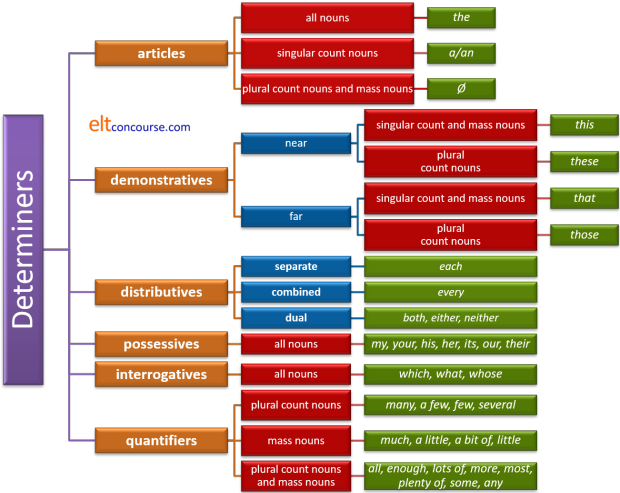
Try a test on these categories
We saw above, when we looked at the some, every, any, no series
of pronouns that the rule given to students, that we reserve any for
questions and negatives, does not work.
Exactly the same considerations apply to the words some and
any when
they are used as determiners rather than pronouns.
Most determiners are uncomplicated in that they can be used in positive, negative and interrogative sentences. Some are less obliging, however. Compare, for example:
- She has some time to spare
- She doesn't have any time to spare
and it is clear that we use some in positive sentences and any in negative ones. As far as it goes, the rule works.
However, we can also allow:
- Would you like some help?
- Can you give me some help?
- Do you have any aspirins?
- Do you want any more money?
The answer as it was above, is to look at the function of the sentence, not its form.
Sentences 3. and 4. are not really questions: Sentence 3. is an
offer and Sentence 4. is a request. In both cases, therefore,
we can use some instead of any.
Sentences 5. and 6. are both real questions so we use any.
 |
Learn moreIf you want to discover more now about determiners, go to: |
 |
Take a test |
You have already done a test on this word class but there are others
in other guides if you want to follow them. If you would like
to try the test you did here again, click
here.
Use the 'Back' button to return when you have done that.
A summary of function words
This diagram is taken from the in-service guide to word and
phrase class.
You can learn more about the various subcategories of the items by
following the links above.

